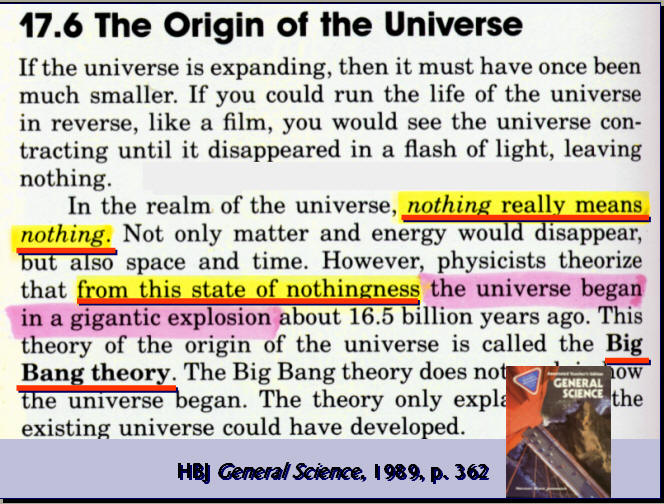
Scientific Objections to Evolution
|
|
Scientific Objections to Cosmic Evolution -
The idea that the universe
(stars, planets, and earth) came from a Big Bang
• Some Evolutionists say that the Universe came from nothing!
· “In the realm of the universe nothing really means nothing. . . from this state of nothingness the universe began in a gigantic explosion 16.5 billion years ago.” (General Science, 1989, p.362)

• Something from Nothing?
· Can something come from nothing?
· No!
· Why not?
· Because “nothing” means there isn’t anything there for something to come from!
• Some Evolutionists say that the Universe has always been here!
• Has The Universe Always Been Here?
· Is it possible that the Universe has just always been here?
· Nope!
· Why not?
· Because that would mean the Universe has been around forever!
· So?
· The Universe can’t last forever – the Universe is wearing out!
•
The Second Law of Thermodynamics:
Everything tends toward disorder
Hebrews 1:10-11 (cf. Psalm 102:25-26)
In the beginning, O Lord, You laid the foundations of the earth, and the heavens are the work of Your hands. They will perish, but You remain; they will all wear out like a garment.
Scientific Objections to Organic Evolution -
The idea that the first living
cell came from non-living chemicals
n “The simplest organism capable of independent life, the karyote bacterial cell, is a masterpiece of miniaturized complexity which makes a spaceship seem rather low-tech . . . that a living organism emerged by chance from a pre-biotic soup is about as likely as that ‘a tornado sweeping through a junkyard might assemble a Boeing 747’ . . . Chance assembly is just a naturalistic way of saying ‘miracle’.” (Darwin on Trial, p.105-106)
Scientific Objections to "Goo-to-You" Evolution -
The idea that all living things
evolved over millions of generations from a single living cell.
Gaps in the Fossil Record
n “Darwin acknowledged that his theory implied that ‘the number of intermediate and transitional links, between living and extinct species, must have been inconceivably great.’ One might suppose that geologists would be continually uncovering fossil evidence of transitional forms. This, however, was clearly not the case. What geologists did discover was species, and groups of species, which appeared suddenly . . .” (Darwin on Trial, p.46)
n “Darwin said that the absence of such intermediates was the ‘most obvious and serious objection’ against his theory. One hundred and twenty years later, Dr. David Raup, head of one of the great museums in America, said that the situation concerning misssing links ‘hasn’t changed much’ and that ‘we have even fewer examples of evolutionary transition than we had in Darwin’s time’.” (Stones and Bones, p.13)
n So what do we have? Evolution expects millions of in-between forms. Some evolutionists claim there are some – maybe a handful of such in-between fossil types. Other leading experts say there are none. (Stones and Bones, p.14)
Limits to Genetic Variation
n “The reason that dogs don’t become as big as elephants, much less change into elephants, is not that we just haven’t been breeding them long enough. Dogs do not have the genetic capacity for that degree of change, and they stop getting bigger when the genetic limit is reached . . . Darwinists disagree with that judgment . . . They point with pride to experiments with laboratory fruitflies. These [experiments] have not produced anything but fruitflies, but they have produced changes in a multiple of characteristics.” (Darwin on Trial, p. 18-19)
Similar Structures Do Not Prove Ancestry
n One of the primary “evidences” that evolutionists offer to “prove” their theory is the similarity of living things. They assume that if two living things have similar characteristics they must be closely related. But this is an unproven assumption.
n Similarities between living things may instead show that living things have a common designer. After all, one would expect a similar design for a similar structure or purpose from the hand of the same Designer.
We Don’t See Evolution Happening -
Information in this sectiuon taken from Carl Wieland’s booklet, Stones and
Bones, 1994, p. 17-18
n Living things do change. But we know that every living thing contains a program (a set of instructions, like a blueprint or a recipe) that specifies whether it will be an amoeba or a horse, for example.
n This information is written on a long molecule called DNA.
|
|
n Evolution teaches that (over millions of years) a comparatively simple creature , like the one celled amoeba, has become a much more complicated one, like a horse.
|
|
n But amoebas clearly do not contain as much information as a horse. They don’t have instructions specifying how to make eyes, blood, brains, hooves, muscles, etc.
n So for an amoeba to become a horse would require an increase in information. Information coding for new structures, new functions – new useful complexity.
n If we saw those sorts of information -increasing changes happening, even if only a few, this could reasonably be used to help support the argument that fish may indeed change into philosophers!
n But the changes that we observe in living things today do not involve increasing information.
n Instead, we see that when living things reproduce, they pass on either the same or less information, not more.
n Therefore the changes that we see are heading in the wrong direction for evolution to occur!